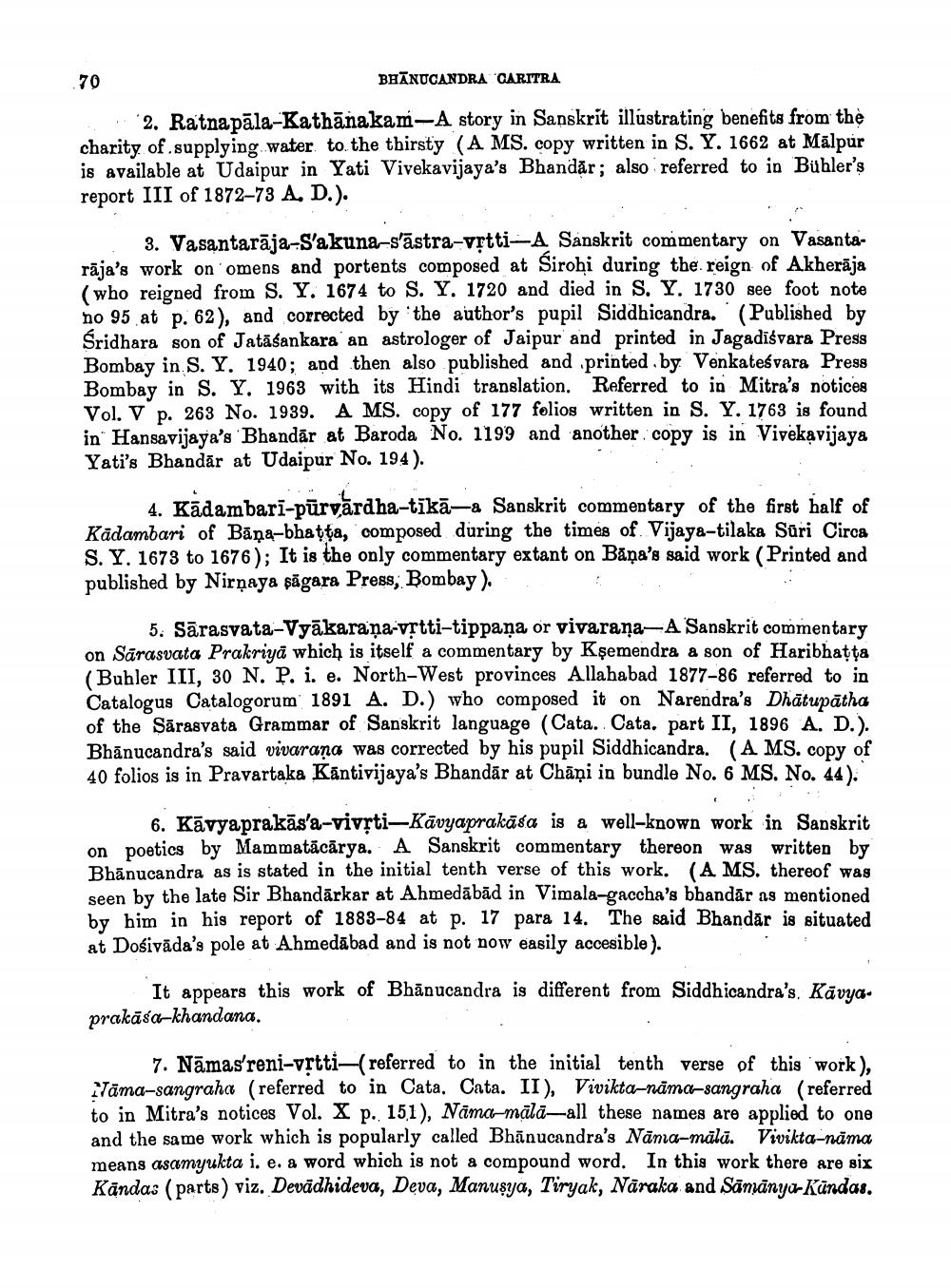________________
70
BHĀNUCANDRA CARITRA.
2. Ratna pāla-Kathānakam-A story in Sanskrit illustrating benefits from the charity of supplying water to the thirsty (A MS. copy written in S. Y. 1662 at Mālpur is available at Udaipur in Yati Vivekavijaya's Bhandar; also referred to in Bühler's report III of 1872–73 A. D.).
3. Vasantarāja-S'akuna-s'āstra-vrtti-A Sanskrit commentary on Vasantarāja's work on omens and portents composed at Sirohi during the reign of Akherāja (who reigned from S. Y. 1674 to S. Y. 1720 and died in S. Y. 1730 see foot note no 95 at p. 62), and corrected by the author's pupil Siddhicandra.. (Published by Sridhara son of Jatāšankara an astrologer of Jaipur and printed in Jagadīśvara Press Bombay in S. Y. 1940; and then also published and printed by Venkateśvara Press Bombay in S. Y. 1963 with its Hindi translation. Referred to in Mitra's notices Vol. V p. 263 No. 1939. A MS. copy of 177 folios written in S. Y. 1763 is found in Hansavijaya's Bhandār at Baroda No. 1199 and another copy is in Vivekavijaya Yati's Bhandār at Udaipur No. 194).
4. Kādambari-pūrvārdha-tīkā—& Sanskrit commentary of the first half of Kadambari of Bāņa-bhatta, composed during the times of Vijaya-tilaka Sūri Circa S. Y. 1673 to 1676); It is the only commentary extant on Baņa's said work (Printed and published by Nirņaya sägara Press, Bombay).
5. Sārasvata - Vyākarana-vrtti-tippaņa or vivarana-A Sanskrit commentary on Sārasvata Prakriya which is itself a commentary by Kşemendra a son of Haribhatta (Buhler III. 30 N. P. i. e. North-West provinces Allahabad 1877-86 referred to in Catalogus Catalogorum 1891 A. D.) who composed it on Narendra's Dhātupātha of the Sārasvata Grammar of Sanskrit language (Cata. Cata. part II, 1896 A. D.). Bhānucandra's said vivarana was corrected by his pupil Siddhicandra. (A MS. copy of 40 folios is in Pravartaka Kāntivijaya's Bhandār at Chāņi in bundle No. 6 MS. No. 44).'
6. Kāyyaprakās'a-vivrti-Kāvyaprakāsa is a well-known work in Sanskrit on poetics by Mammatācārya. A Sanskrit commentary thereon was written by Bhānucandra as is stated in the initial tenth verse of this work. (A MS. thereof was seen by the late Sir Bhandārkar at Ahmedābād in Vimala-gaccha's bhandār as mentioned by him in his report of 1883-84 at p. 17 para 14. The said Bhandār is situated at Dośivāda's pole at Ahmedabad and is not now easily accesible).
It appears this work of Bhānucandra is different from Siddhicandra's, Kāvya. prakasa-khandana.
7. Nāmas'reni-yrtti-referred to in the initial tenth verse of this work), Nāma-sangraha (referred to in Cata. Cata. II), Vivikta-nama-sangraha (referred to in Mitra's notices Vol. X p. 151), Nāma-malā—all these names are applied to one and the same work which is popularly called Bhānucandra's Nāma-mälu. Vivikta-nama means asamyukta i. e. a word which is not a compound word. In this work there are six Kāndas (parts) viz. Devādhideva, Deva, Manusya, Tiryak, Nāraka and Sāmānyu-Kündas,




